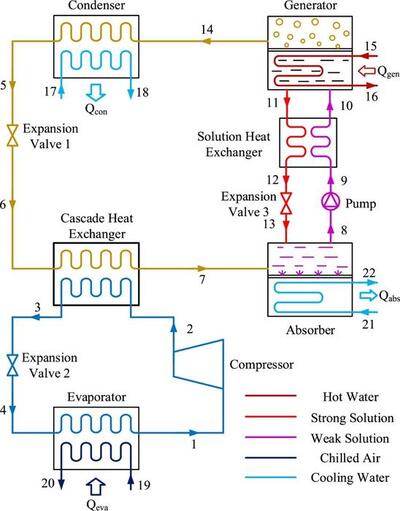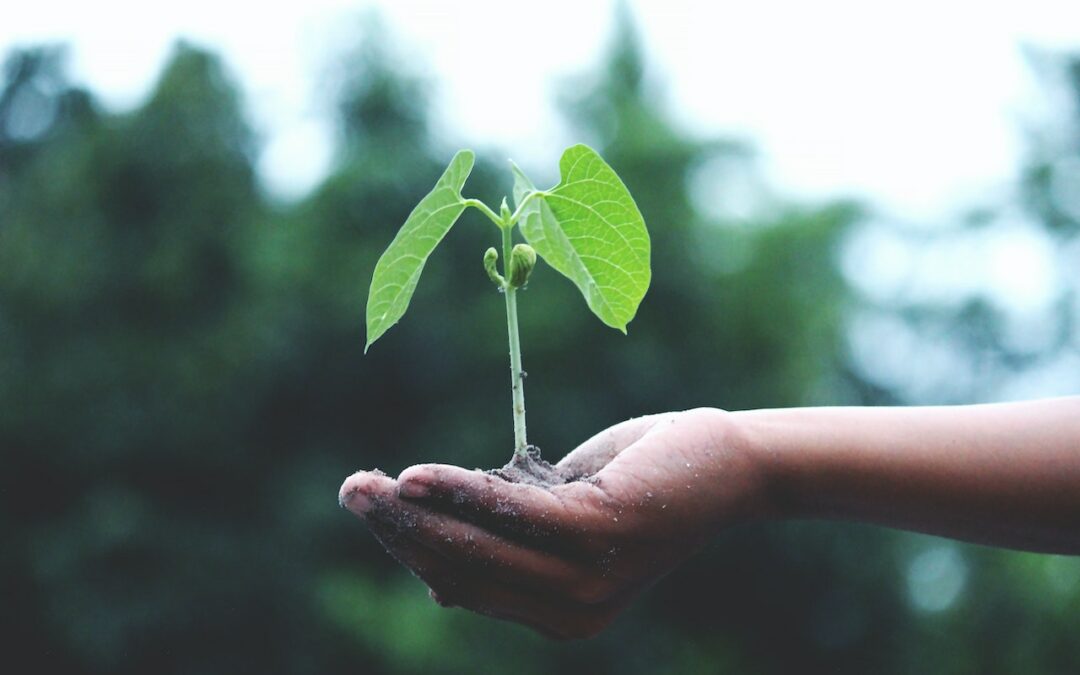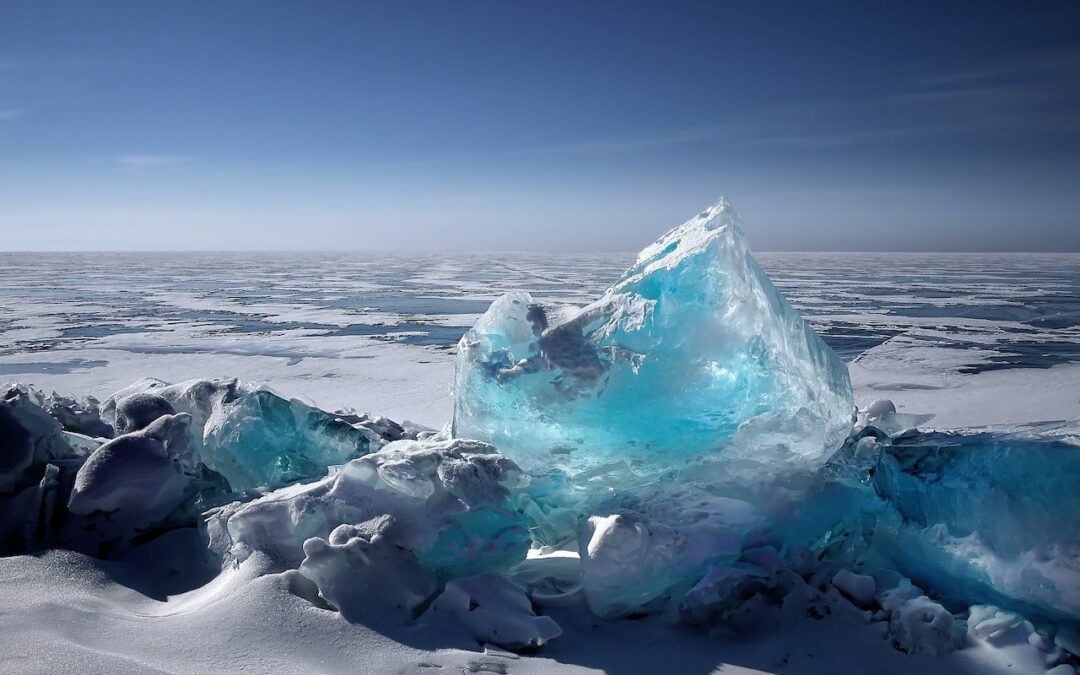
by Komoneed | Apr 12, 2024
Researchers from Xi’an Jiaotong University in China have made significant inroads into sustainable refrigeration.
Their work involved fine-tuning the compression-absorption cascade refrigeration cycle (CACRC) — a system that combines vapour-compression refrigeration (VCR) with an absorption refrigeration cycle (ARC).
CACRC presents a promising answer to the pressing energy demands and environmental concerns associated with traditional cooling methods. While VCR is known for its superior performance and ability to achieve low temperatures at a high energy cost, ARC, in contrast, operates with minimal electricity, utilising waste heat. The harmonious combination of these two systems has generated keen interest in CACRC, particularly its potential utility in critical areas such as food preservation and district cooling.
Image caption: Schematic diagram of the CACRC system. Image credit: Yuhan Du, et al, published under CC BY-NC-ND.
Exploring a dual-section mechanism that combined vapour-compression with absorption refrigeration technologies, the research team conducted a thorough analysis of 16 distinct refrigerants in the vapour compression section, paired with H2O-LiBr in the absorption section.
Their meticulous examination aimed to identify the most efficient and eco-friendly combinations, revealing the RE170/H2O-LiBr pair as the standout performer. This pair demonstrated the highest coefficient of performance and energy efficiency among all candidates. The team further investigated the system’s dynamics, including the impacts of generator and evaporator temperatures, cascade temperature differences and the effectiveness of the solution heat exchanger.
“This breakthrough not only marks a significant step towards more sustainable refrigeration practices but also reflects our dedication to pioneering solutions that can revolutionise industries and contribute to the preservation of our planet’s resources,” said Xiaopo Wang, the study’s lead author.
The study was published in Energy Storage and Saving in February 2024.
Image credit: iStock.com/chabybucko

by Komoneed | Apr 12, 2024
Curtin University has received a $5 million grant from the Australian Renewable Energy Agency (ARENA) to take on the challenge of producing and transporting hydrogen in a sustainable and cost-effective way.
While hydrogen has long been identified as a clean energy source, there are difficulties in transporting it affordably and practically.
One established method is using sodium borohydride powder as a carrier for the hydrogen, but the by-product left behind — sodium metaborate — has always been expensive to recycle.
The Kotai Hydrogen Project has been set up to trial a new method of hydrogen production and transportation being developed by Curtin’s Hydrogen Storage Research Group (HSRG) in partnership with Velox Energy Materials.
The HSRG’s award-winning chemical process and catalyst has the potential to quickly and cheaply revert sodium metaborate back to sodium borohydride, enabling it to be reused to transport hydrogen.
“The lower costs attached to this method’s production and transport could make it potentially the cheapest means of exporting hydrogen from Australia,” said John Curtin Distinguished Professor Craig Buckley, head of the HSRG.
“This method could play a part in meeting the rapidly rising global demand for Australian hydrogen.”
Buckley added that the Kotai Hydrogen Project could be a significant step towards zero net emissions.
“Our aim is to provide a circular hydrogen export value chain,” he said. “The initial research component of the project will feed into the commercial stage, where a pilot facility will be designed and built in Perth to evaluate the technology for large-scale production directly from renewable electricity.”
Curtin Institute for Energy Transition Director Professor Peta Ashworth said the project was important on a global scale.
“The whole world has been working to reduce the end-to-end costs of clean hydrogen,” Ashworth said.
“Having been involved in the early development of Australia’s Hydrogen Strategy, it is fantastic to see Australia playing a significant part in delivering on that aspiration through this funded Curtin research.”
Curtin and Velox Energy Materials will also contribute an additional combined cash commitment towards the overall project.
ARENA Chief Executive Officer Darren Miller said that through its strategic priorities, ARENA had highlighted the importance of renewable hydrogen and low-emissions metals as a potentially significant export industry.
“Innovation starts in the lab and we have the best minds taking our decarbonisation efforts to the next level — to the benefit of all Australians through jobs, lower emissions and cheaper energy,” he said.
Image credit: iStock.com/Scharfsinn86

by Komoneed | Apr 12, 2024
Peters Valley School of Craft enriches lives through the learning, appreciation, and practice of fine craft. For more than 50 years, accomplished artists and students have come together as a community to harness the power of creativity and joyous lifelong learning in the beautiful Delaware Water Gap National Recreation Area. We are firmly dedicated to inclusion, diversity, equity, and access and welcome the experienced professional artist, the new learner, the collector—and everyone in between—to be touched by the power of craft. More
Do stories and artists like this matter to you? Become a Colossal Member today and support independent arts publishing for as little as $5 per month. The article Peters Valley School of Craft Offers Fine Craft Programming in the Delaware Water Gap National Recreation Area appeared first on Colossal.

by Komoneed | Apr 11, 2024
Editor’s Pick: Mitigation Low-Emissions Agriculture Blogs
jschoshinski
Tue, 04/09/2024 – 14:00
Increased extreme weather events and shifts in seasonal patterns, including temperature and precipitation, are having a significant negative impact on agriculture production, livelihoods, and food security. USAID is developing and scaling climate-smart agriculture practices that both respond to the threats posed by climate impacts and reduce greenhouse gas emissions from the sector. The following blogs reflect the March and April theme of Mitigation and Low-Emissions Agriculture, as well as highlight some of the ways USAID is working at the intersection of climate and agriculture and food systems.
Advancing Low-Emissions Agriculture and Food Systems: How USAID is Championing Food Security and Climate Action
At COP28, the United States signed the Sustainable Agriculture, Resilient Food Systems, and Climate Action declaration, which is a global recognition that climate and food security goals go hand-in-hand. USAID’s 2022-2030 Climate Strategy also recognized this intersection, explicitly calling for food systems transformation that contributes to climate change mitigation. Currently, USAID’s approach to Low-Emissions Agriculture and Food Systems focuses on targeted emissions reductions, as well as support of adaptation efforts with mitigation co-benefits through multiple funding streams, including agriculture, climate, biodiversity, water, and governance.
Integrated Rice-Fish Farming in Nigeria: A Resilient Approach in the Face of Climate Change
Severe weather events such as flooding, drought, and rising temperatures are endangering the livelihoods of fishing and farming communities in Nigeria. To address this, the Feed the Future Innovation Lab for Fish introduced farmers to a new method of growing rice and fish in the same aquatic ecosystem. This approach reduces greenhouse gas emissions and builds food supply, boosting nutrition in the community.
More Milk with Fewer Cows: The Potential for Methane Reduction in Kenya’s Dairy Sector
The agriculture and livestock sector is critically important to food security, nutrition, and economic growth in many low- and middle-income countries, including Kenya. The impact of this sector on climate change, particularly through methane emissions, is a concern, but USAID is championing potential win-win agricultural interventions that can meet both climate and food security goals. In Kenya, the Feed the Future Kenya Crops and Dairy Activity works with farmers to improve their milk yield and productivity in a way that generates positive benefits for the environment.
Conservation Agriculture a Saving Grace for the Kavango Region
Rural communities in the Namibian catchment areas of the Okavango River Basin rely on rain-fed farming, so poor rainfall caused by climate change is exacerbating food insecurity. USAID’s Resilient Waters Program spearheaded a climate adaptation initiative by equipping farmers with innovative climate-smart skills to minimize the likelihood of negative outcomes from climate shocks. In just two months, Resilient Waters trained 552 farmers on Conservation Agriculture, a modern sustainable agriculture production technique.
Cultivating Sustainable Solutions for Peru’s Cacao Farmers
The USAID-supported Peruvian Extension and Research Utilization Hub (PERU-Hub) helps farmers in Peru combat climate challenges and prevent losses that could hurt their livelihoods and weaken Peru’s economy. The Hub explores the application of advanced technologies to climate resilience, crop diversification, and food production with the goal of reducing greenhouse gas emissions by more than 200 tons CO2e by 2026.
Teaser Text
The following blogs highlight some of the ways USAID is working at the intersection of climate and agriculture and food systems.
Publish Date
Tue, 04/09/2024 – 12:00
Author(s)
Jamie Schoshinski
Hero Image
Salihu’s explains bumper yield in his biofertilized rice farm.jpg
Blog Type
Blog Post
Strategic Objective
Adaptation
Mitigation
Integration
Region
Global
Topic
Agriculture
Climate-Resilient Agriculture
Biodiversity Conservation
Emissions
Climate Strategy
Food Security
Indigenous Peoples and Local Communities
Methane
Mitigation
Nutrition
Resilience
Weather
Country
Kenya
Namibia
Nigeria
Peru
Sectors
Agriculture and Food Systems

by Komoneed | Apr 11, 2024
The Australian Institute of Packaging (AIP) is collaborating with sustainability software company Empauer to offer a comprehensive life cycle assessment (LCA) package for small to medium enterprises (SMEs) in Australia, New Zealand and Asia.
The aim is to support SMEs in making informed and science-based decisions when selecting packaging materials. This can be a challenging process, something the AIP observed in its SME training programs, where it identified a pressing need for affordable and customised LCA solutions that simplify the sometimes complex business of undertaking sustainability assessments for packaging design.
The report part of the package can be utilised for internal decisions, including selection of packaging materials and components. It can also help SMEs navigate the shift towards more sustainable alternatives within the business.
The LCA Decision Package is designed to provide AIP members and the wider industry with access to the latest tools and expertise, enabling them to reduce their environmental footprint and make responsible choices in line with global sustainability goals.
The AIP said that the main benefit to SMEs in using the LCA Decision Package was that users did not have to understand all the complexities of LCAs, as they will be provided with the comparison information and assistance to understand the environmental impact for each packaging material choice, depending on the parameters they select.
Interested SMEs can complete and submit an online expression of interest form and a brief questionnaire by visiting https://lnkd.in/gV-8CxAH.
Further enquiries can be emailed to info@empauer.com.
Image credit: iStock.com/Parkpoom




